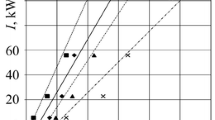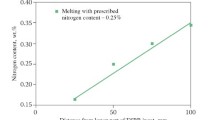Conclusions
Maraging steels treated for maximum hardness or overaging exhibit high cavitation-corrosion resistance in acid solutions as a result high strength and resistance to microcrack initiation and propagation, whose develoment is typical for the stage of intense cavitation. In view of this, in order to improve the endurance of components operating under cavitation conditions in corrosive media, and to reduced equipment stoppages for repair, it is recommended that high alloy austenitic corrosion-resistant steels are substituted by maraging steels.
Similar content being viewed by others
Literature cited
I. N. Bogachev, Cavitation Failure and Cavitation-Resistant Alloys [in Russian], Metallurgiya, Moscow (1972).
I. N. Bogachev, E. V. Savalei, and T. D. Éismondt, "Effect of austenitic transformation on the cavitation resistance of unstable austenitic steels", Fiz.-Khim. Mekh. Mater.,13, No. 6, 78–80 (1977).
A. A. Rudakov, I. N. Bogachev, and V. A. Sintsov, "Properties of high-strength cavitation-resistant steel 08Kh13N3G5", Lit. Proizvod., No. 2, 9–11 (1979).
C. J. Heathcock, B. E. Protheros, and A. Ball, "The influence of microstructure on the cavitation erosion of materials", Strength of Metals and Alloys. Proc. 5th Int. Conf. Aachen, Toronto, Vol. 1, 219–224 (1979).
V. V. Fomin, Hydraulic Erosion of Metals [in Russian], Mashinostroenie, Moscow (1977).
L. I. Kovalev and I. A. Povyshev, "Cavitation resistance of chromium-manganese steel grade 04Kh15G14M with a structure of unstable austenite", in: Processes of Construction, Welding, and Assembly of Ships [in Russian], Leningrad (1981).
B. A. Pomekhin and I. N. Bogachev, "Stress relaxation in chromium-manganese austenitic steel 30Kh10G10", Fiz. Met. Metalloved.,18, No. 2, 257–262 (1964).
V. V. Berezovskaya, Yu. G. Veksler, and N. A. Manakhova, "Effect of prior cold deformation on the cavitation-corrosion resistance of steel 12Kh18N9T", Metalloved. Term. Obrab. Met., No. 57–59 (1986).
V. D. Yaroshevich and D. T. Rybkina, "Plastic deformation and failure of crystalline solids", Fiz. Met. Metalloved.13, 617–627 (1975).
M. G. Timerbulatov, "Effect of corrosion and cavitation intensity on metal resistance characteristics under laboratory and operating conditions", in: Proc. Coordination Meeting on Hydrotechnology. Methods of Laboratory Cavitation-Erosion Testing [in Russian], Energiya, Leningrad (1974).
M. N. Bodyako, S. A. Astapchik, and G. B. Yaroshevich, Maraging Steels [in Russian], Metallurgiya, Moscow (1970).
Additional information
Ural Polytechnic Institute. Translated from Metallovedenie i Termicheskaya Obrabotka Metallov, No. 11, pp. 50–56, November, 1987.
Rights and permissions
About this article
Cite this article
Berezovskaya, V.V. Structural factors governing steel resistance during operation in corrosive media under cavitation conditions. Met Sci Heat Treat 29, 863–869 (1987). https://doi.org/10.1007/BF00707761
Issue Date:
DOI: https://doi.org/10.1007/BF00707761




